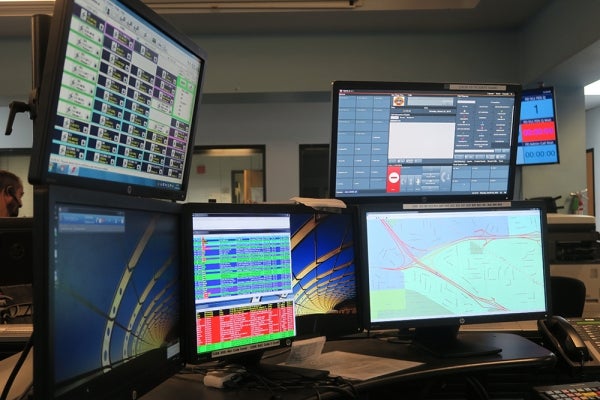
ECDC's mission is to process requests for assistance and initiate timely dispatch of emergency resources by utilizing technology to receive and dispatch information to the Fire Rescue Department and to the citizens of San Diego.
Located in Kearny Mesa, ECDC is a secondary public safety answering point, processing about 350,000 emergency calls each year and managing over 200,000 incidents. All Fire Dispatchers are highly trained and certified as Emergency Medical Dispatchers (EMD) through the International Academy of Emergency Dispatch.
View current incidents with SDFD Dispatch Online.
What happens when you call 911?
If your call is medical or fire related, you will be transferred to ECDC, where your call will be answered by a Fire Dispatcher.
When you call 9-1-1, you should be ready to provide:
- City, location, address
- Cross street
- Phone number
- Description of the emergency
Remember, try to remain calm so the dispatcher can help you.
Staffing
ECDC is staffed 24 hours a day/7 days a week by up to 51 full-time Fire Dispatchers, working 12-hour shifts. Each shift is overseen by a Fire Dispatch Supervisor and a Command Battalion Chief. Overall, ECDC is overseen by a Deputy Fire Chief.
The Communications Division also includes Training and Quality Assurance Staff, Information Systems Staff, a Data/Analytics Team, and GIS Staff.
Frequently Asked Questions
How do I become a Fire Dispatcher?
You can learn more about being a Fire Dispatcher and the application process/a>.
What type of technology is used by Dispatchers?
Fire Dispatchers use a Computer Aided Dispatch (CAD) system, specialized phone system, and digital radio console to perform their work. The CAD system is what dispatchers use to enter calls for service and, through automatic vehicle location technology, can recommend the most appropriate resources for responses. In addition to the CAD, dispatchers utilize RapidSOS and RapidDeploy to assist in accurately locating cell phone callers. All of this technology integrates with First Responders to provide station alerting, notifications, and real-time updates.
If you are calling from a landline or VOIP phone, your address and phone number are displayed on the dispatcher’s screen. If you are calling from a cell phone, the dispatcher will likely have your phone number, and through technology such as RapidSOS and RapidDeploy, will likely also see your location on their map. In some situations, locations are not always visible to the dispatcher for cell phone calls.
Why do dispatchers ask so many questions?
Fire Dispatchers follow a predetermined set of questions and protocols. Based on your responses, they can determine the best level of care and help for you. The dispatcher’s questions do not delay the fire or ambulance crew’s arrival.
Do Fire Dispatchers provide medical care instructions before the arrival of Emergency Services?
All SDFD Dispatchers are trained and certified as emergency medical dispatchers. This training provides them with the knowledge and skills to talk callers through lifesaving techniques while emergency crews are the way to you. When necessary, dispatchers provide instructions on performing CPR, controlling bleeding, the Heimlich maneuver, and childbirth, to name a few.
What should I do if a dispatcher doesn't immediately answer when I call?
If you receive a busy signal after dialing 9-1-1 from a cellular phone, hang up and try again.
If you receive a recording after dialing 9-1-1 from a standard phone, stay on the phone and do not hang up! Calls are received in a time queue and are answered in the order they are received. If you hang up and place a second call, the cycle begins all over again, and your call is delayed. It is not unusual during large incidents for many people to call to report the same incident. Be patient, and do not hang up. We may need more information, and you may be the person who has it!

